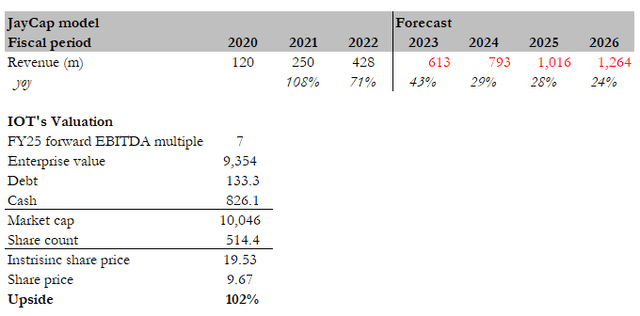metamorworks
Overview
I believe Samsara (NYSE:IOT) is undervalued. Samsara aims to improve the efficiency, sustainability, and safety of operations that power the global economy. As an IoT pioneer, Samsara’s solution consists of a Connected Operation Cloud. It allows businesses in a range of industries to unlock the value of IoT data and improve their operations. IOT purpose-built platforms provide a digital hub for physical operations, which sets it apart from its competitors.
Business description
Samsara is the pioneer of the Connected Operations Cloud. It enables businesses (that depend on physical operations) to use IoT (Internet of Things) data to provide practical business insights and improve their performances. The company’s Connected Operation Cloud consolidates data from its IoT devices, making it easy for organizations to access, evaluate, and act on data insights using its cloud dashboard, custom reports and alerts, workflows, and mobile apps.
The company provides end-to-end solutions for operations. The company’s differentiated, purpose-built portfolio of solutions enables organizations to adopt and implement a cloud-connected digital strategy throughout their operations. Its solution connects physical operations data to its “Connected Operations Cloud,” which consists of the company’s Data Platform and Applications. Its Data Platform ingests, aggregates, and enriches data from its IoT devices. However, the growing ecosystem of connected assets and third-party systems makes the data actionable for the use cases through its applications.
IOT lets customers run their businesses in a safer way, make their businesses more efficient, and reach their sustainability goals, all of which improve the lives of their employees and the people they serve.
Investments thesis
Digital transformation is an unstoppable force
Digital transformation is imperative for companies to compete. Companies that successfully transform operations through modern applications, digital workflows, and intuitive user experiences often benefit from devoted customers. Furthermore, innovative products and scalable business models also boost the profitability of companies. The growth of smart devices, cloud applications, diversifying user groups, and rising customer expectations drive digital transformation. In the retail, advertising, media, and information technology industries, for example, digital-first entrepreneurs have completely changed the way businesses have been run for decades.
Many industries (including transportation, wholesale, and retail commerce) that rely on physical operations have slowly embraced digital transformation. These industries represent a sizable, untapped opportunity for digital transformation. Despite their size and crucial role in the global economy, many businesses in these sectors still heavily utilize manual processes, archive data, spreadsheets, and older software. These physical operations could be more manual, effective, and suitable for providing consumers with actionable insights. Businesses that rely on physical operations are in a unique position to use connected IoT assets to create real-time operational data and use AI to gain insights, experiment with automation, and make their business processes more efficient.
Furthermore, many operations-intensive companies depend on expensive equipment and assets. These operations-intensive companies deploy a sizable field workforce that requires coordination, handles the demanding accuracy of intricate logistics, and manages industry-specific workflows requiring specialist knowledge. These companies must follow various regulatory requirements while emphasizing sustainability, efficiency, and safety. However, certain downsides of these businesses (including inefficient energy usage, maintenance downtime, improper resource allocation, security breaches, complacency, and risky work practices) can lead to significant business risks, including high costs, high turnover, and reduced profits. Digital technology adoption is essential for operations-intensive firms to remain competitive and adaptable.
However, industries that rely on physical operations are facing many challenges today, including:
- Lack of data access and siloed systems: A lot of physical operations-related assets (such as fleets of vehicles, industrial equipment, factories, and distant equipment) produce massive amounts of operational data that are frequently inaccessible. Even when the data is accessible, it is spread across several siloed systems made up of hardware and software parts from different manufacturers. Combining data in the cloud and creating useful business insights is challenging because of limited data access and siloed systems.
- Breadth and diversity of data: Users’ ability to combine various data kinds and make better operational decisions is constrained by the breadth and diversity of data gathered from physical operations. It might be challenging to clean up and normalize this structured and unstructured data before analysis. Organizations must be able to normalize the data and comprehend the connections between various disconnected data sets to gain value from the data. In order to identify areas for improvement, businesses should be able to benchmark against best-in-class performers and competitors.
- Reliance on legacy tools: Many operations-intensive companies rely on legacy tools to oversee and execute discrete jobs. These legacy tools, which were created decades ago, were not created for scale analytics. In contrast, other companies continue to use paper and spreadsheets.
IOT connects relevant data points to provide a bird’s-eye view of physical operations
Samsara’s cloud-based Data Platform is where the data gathered by their solutions is stored and analyzed. Samsara uses self-installed, plug-and-play IoT devices to glean information from assets that don’t have built-in sensors. Offline assets with in-built sensors can be connected to the internet via these. Then, Samsara’s Data Platform, which collects data from many IoT sources, gives customers a “single pane of glass” view of their physical operations across their whole organizations.
Samsara also integrates with key systems such as ERP and work order applications to merge operational IoT data with customer IT data. With that, Samsara gives users a unified data operating system, so you don’t have to deal with multiple software and hardware systems. It also gives you a full view of your assets by prioritizing and benchmarking them.
IOT solutions improves operational efficiency and reduces costs
Samsara’s Data Platform enables customers to increase productivity by automating previously manual operations and making data-driven decisions. The ultimate results are making decisions in real-time and using time and resources more effectively.
For instance, IOT routing and dispatching program helps its customers to select routes that use less gasoline by leveraging real-time information on traffic conditions and delivery delays. IOT customers also benefit from productivity gains by automating procedures and digitizing documentation for regulatory compliance.
Furthermore, IoT enables its customers to actively monitor safety risks by utilizing IoT data and AI to identify patterns and enhance their safety programs. For instance, IOT processed more than 38 billion minutes of video in 2020. That video featured abrupt braking, distracted driving, abrupt turning events, and people and motion alerts, and the company used all of them to track and enhance the physical operations of its customers. By providing video evidence of incidents, IOT also assists in defending its customers against erroneous claims, which may result in lower insurance costs for them.
IOT purpose-built platform sets it apart from peers
The IOT cloud-native Data Platform allows businesses to improve their processes. In order for the IOT Data Platform to derive value from the trillions of IoT data points at its disposal, a thorough comprehension of operations via cases and data is required. For instance, the IOT Data Platform can correlate data on hard braking with data on video safety to determine whether a braking incident was safe or not. By integrating multiple data sources and taking into account the surrounding environment, IOT users can determine if the driver’s stopping habits require inspection.
Moreover, the company has taken advantage of the rising power of IoT computation, recognizing that this will allow it to offer its customers instantaneous access to in-depth analyses. The edge computing capabilities of IoT are tailored to the specific requirements of physical operations. For instance, IoT can take in video and immediately analyze it at the edge to alert drivers or security operators to tailgating, safety risks, unsafe work settings, and distracted driving in real time. With the daily data it collects, the company can improve its AI algorithms and give better insights and alarms that fit the physical operations at the edge.
In order to collect and process critical data in real time, even in low-bandwidth or latency situations, IoT devices use edge computing.
Forecast
My model suggests that IOT has potential to increase by 100% from the current share price. This is based on consistent high growth rates, and no change in valuation multiples. Below are the key assumptions:
- Historical growth has been very strong which indicates execution success and momentum. Since there are no structural changes to the business, growth should remain at high rates
- IOT differentiated product should enable it to sustain high growth rates
- FY22 growth rate is based on management’s guidance, which was raised from the previous guidance. This is clear indication of momentum
Using these assumptions, IOT could be worth 100% more than its current share price of 9.67.
Red flags
Inherent risk
Reputational damage could occur to IOT if a security breach or incident compromises customer data, company data, IoT devices, or the Data Platform.
Rapid technological change
The company participates in industries that are exposed to quick technological change. The competitive environment will continue to be significantly impacted by the advent of new technology. The company needs to keep giving its customers more value by coming up with new apps that help IOT customers keep track of and manage their fleets, equipment, sites, and other connected assets.
Competition
IOT competes in new and quickly developing markets for applications and uses cases. Some of its competitors are more financially stable and have more recognizable brands, bigger sales teams, bigger marketing budgets, and wider distribution networks than IOT. Large organizations, in particular, used their distribution networks and established connections to offer fleet management solutions and solutions in other business verticals that were already being offered to customers.
Conclusion
IOT has the potential to increase by 100% from its current share price. Combining IoT connectivity, AI, cloud computing, and video imagery, IOT is digitally transforming physical operations. It strives to help many industries streamline their operations while improving efficiency, sustainability, and safety by connecting IoT. The company offers a unique edge to keep investors interested.



Be the first to comment